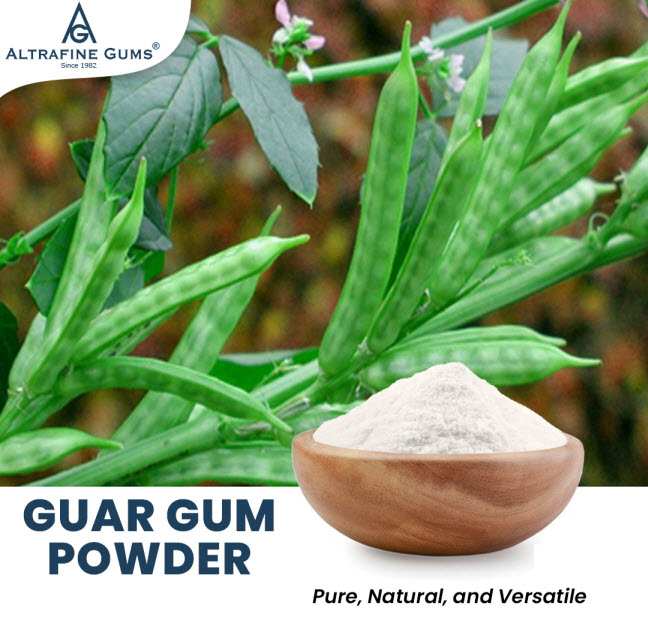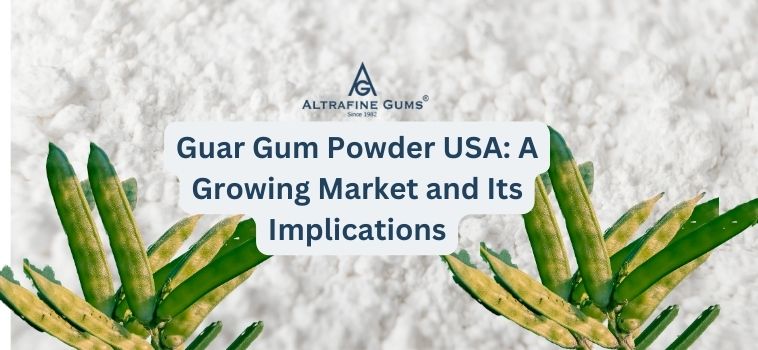Demand for Guar Gum in the USA
The United States is experiencing a significant rise in demand for guar gum powder, a natural thickener and stabilizer extracted from the seeds of the guar plant. This demand spans various industries, with guar gum playing a critical role in food, oil and gas, and cosmetics sectors. Each of these industries capitalizes on the unique properties of guar gum, making it a versatile and sought-after ingredient.
- Food Industry: Guar gum is widely used in food products as a thickening and stabilizing agent. It enhances the texture and consistency of dairy items like ice cream, keeps sauces from separating, and provides elasticity to gluten-free baked goods. The shift toward healthier, plant-based, and gluten-free diets has further fuelled its popularity in food applications.
- Oil & Gas Industry: A considerable portion of guar gum demand comes from the oil and gas sector, where it is used in hydraulic fracturing (fracking) to increase the viscosity of water-based solutions. The gum’s gelling properties enable efficient extraction of oil and gas from deep rock formations, making it a crucial component in the energy industry.
- Cosmetics and Personal Care: In personal care products, guar gum serves as a thickener and conditioner. It is used in shampoos, lotions, and creams, offering a smooth, luxurious texture and conditioning benefits for hair and skin.
- Market Insight: With growing consumer awareness of natural and plant-based products, the U.S. market for guar gum is expected to expand further, as more companies look to incorporate eco-friendly ingredients into their products.
Regulatory Standards and Quality Assurance
In the United States, guar gum used in food and pharmaceutical applications must meet rigorous regulatory standards to ensure product safety and quality.
- FDA Regulations: The Food and Drug Administration (FDA) has designated guar gum as a Generally Recognized As Safe (GRAS) additive. This means manufacturers must comply with strict regulations, including ensuring the purity of guar gum, proper labeling, and adhering to allowable usage limits in food products.
- Quality Certifications: Guar gum producers and importers often secure certifications like ISO (International Organization for Standardization), GMP (Good Manufacturing Practices), and HACCP (Hazard Analysis and Critical Control Points). These certifications are crucial for gaining consumer trust and meeting industry standards, particularly for food and pharmaceutical uses.
- Importance of Compliance: Companies that fail to adhere to these regulatory standards risk facing penalties, product recalls, or loss of consumer trust. Maintaining high-quality assurance measures is vital for sustaining a successful presence in the market.

Challenges Faced by U.S. Manufacturers and Importers
While the U.S. market for guar gum is growing, it is not without challenges. Supply chain disruptions, climate-related issues, and fluctuating prices are significant obstacles for manufacturers and importers.
- Supply Chain Issues: The majority of guar gum is sourced from India and Pakistan, which makes the supply chain vulnerable to geopolitical tensions, trade restrictions, and logistical challenges. Any disruptions in these regions can impact the availability of guar gum in the United States.
- Climate Impact on Guar Crops: The production of guar beans is heavily dependent on the monsoon season. Unpredictable weather patterns, such as droughts or excessive rainfall, can lead to poor crop yields, causing supply shortages and price hikes.
- Fluctuating Prices: The cost of guar gum is highly influenced by demand from the oil and gas sector, crop yield, and global economic conditions. These price fluctuations can make it difficult for businesses to plan budgets and manage costs effectively.
- Mitigation Strategies: Companies are exploring options like diversifying their supply sources, investing in sustainable agricultural practices, and securing long-term supply agreements to mitigate these challenges.
Sustainability and Environmental Considerations
Sustainability is a growing concern in the guar gum market, especially as consumers and businesses become more environmentally conscious. The U.S. market is placing a greater emphasis on eco-friendly and sustainable sourcing practices.
- Sustainable Sourcing: U.S. companies are increasingly partnering with suppliers who employ sustainable farming practices. This includes crop rotation, organic farming, and efficient irrigation techniques to reduce water usage. These practices help ensure the long-term viability of guar bean farming and minimize environmental impact
- Biodegradability and Eco-Friendliness: As a plant-based, biodegradable ingredient, guar gum is a more sustainable option compared to synthetic thickeners and stabilizers. Its natural origin and eco-friendliness align with the growing trend toward green and organic products in both the food and personal care industries.
- Corporate Responsibility: Many companies are also investing in carbon footprint reduction initiatives and transparency in their sourcing practices. This commitment to sustainability not only appeals to environmentally conscious consumers but also supports global efforts to combat climate change.
Applications in the U.S. Food Industry
The versatility of guar gum makes it a valuable ingredient in the American food industry, where it is used to improve texture, stability, and shelf life.
- Ice Cream and Dairy Products: Guar gum is crucial in ice cream production, as it prevents ice crystals from forming and gives a smooth, creamy texture. It also stabilizes dairy-based drinks, keeping the ingredients evenly distributed.
- Gluten-Free Baking: Guar gum is a key ingredient in gluten-free recipes, as it provides the elasticity and structure that gluten would normally offer. It helps bind ingredients, resulting in baked goods with a better texture and consistency.
- Sauces and Salad Dressings: The thickening properties of guar gum prevent separation in sauces and salad dressings, ensuring a consistent and appealing product.
- Processed Foods: In processed meats and canned goods, guar gum improves water retention and texture, enhancing product quality and shelf life.
- Health and Dietary Trends: With the rise of gluten-free and plant-based diets, guar gum has become an essential ingredient for food manufacturers looking to cater to health-conscious consumers.
Future Trends and Market Predictions
The guar gum market in the United States is poised for continued growth, with several trends shaping its future.
- Technological Advancements: Innovations in processing technology are enhancing the performance of guar gum, making it more versatile and efficient for various applications. Improved formulations and new product developments are likely to emerge, further expanding its market potential.
- Natural Ingredient Demand: As consumers become more health-conscious and eco-aware, the demand for natural, non-GMO, and allergen-free ingredients is expected to increase. Guar gum’s natural origin and health benefits make it a preferred choice for food and cosmetic products.
- Oil & Gas Industry Recovery: A potential rebound in the oil and gas sector could drive demand for guar gum used in fracking fluids. This growth may influence overall market dynamics and pricing.
- Market Outlook: Analysts predict steady growth for the guar gum market over the next decade. Companies that prioritize sustainability and innovation are likely to have a competitive edge in this evolving market.

FAQs About Guar Gum Powder USA
1. What is guar gum, and why is it in high demand in the USA?
Guar gum is a natural thickening and stabilizing agent derived from guar beans. It is in high demand due to its widespread use in food, oil and gas, and cosmetics industries.
2. How does the U.S. food industry use guar gum?
It is used to thicken and stabilize products like ice cream, dairy-based beverages, gluten-free baked goods, sauces, and dressings.
3. What are the FDA regulations for guar gum?
The FDA classifies guar gum as a GRAS (Generally Recognized as Safe) food additive. Manufacturers must follow strict guidelines on purity, labeling, and permissible usage levels.
4. What challenges do U.S. manufacturers face with guar gum supply?
Challenges include supply chain disruptions, climate impact on guar crops, and price fluctuations driven by global demand and crop yields.
5. How is the guar gum market addressing environmental concerns?
Companies are focusing on sustainable sourcing practices, such as water-efficient farming and organic cultivation, to minimize environmental impact.
6. Why is guar gum preferred over synthetic thickeners?
Guar gum is natural, biodegradable, and safe for consumption, making it a healthier and environmentally friendly alternative.
7. How does climate change affect guar gum supply?
Climate change impacts monsoon patterns, which can lead to poor guar bean harvests and affect supply and pricing.
8. What are the future trends in the guar gum market?
Future trends include increased demand for natural ingredients, technological advancements, and potential growth in the oil and gas industry.

